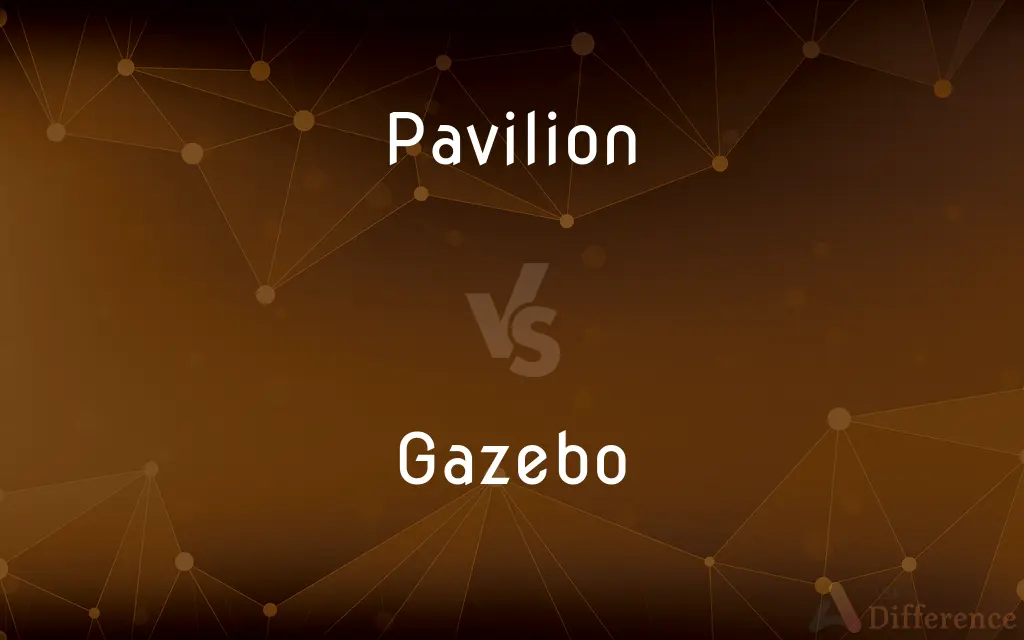Pavilion vs. Gazebo — What's the Difference?
By Fiza Rafique & Urooj Arif — Updated on March 11, 2024
A pavilion is a large, often ornate structure, used for events and public gatherings, whereas a gazebo is a smaller, typically octagonal structure, primarily used for enjoying garden views.

Difference Between Pavilion and Gazebo
Table of Contents
ADVERTISEMENT
Key Differences
Pavilions are versatile structures, often used for large public events, sports, or exhibitions, characterized by their open sides and sometimes temporary nature. They can be found in parks, exhibition grounds, or as part of larger buildings. On the other hand, gazebos are much smaller, freestanding structures, usually found in gardens or parks, designed for relaxation and enjoying the outdoors. They are often octagonal or round, with a solid roof and open sides, providing shelter while allowing a panoramic view of the surroundings.
While pavilions are designed to accommodate large groups of people, making them ideal for concerts, picnics, or sports events, gazebos are more intimate, suitable for small gatherings, quiet reflection, or as an attractive garden feature. The size and design of pavilions allow for versatility in use, from serving as a bandstand to hosting large community events, whereas gazebos offer a personal escape, often becoming a focal point in garden design.
Pavilions can be temporary or permanent structures, made from materials like fabric for temporary setups or wood and metal for permanent ones. They are adaptable to various events, such as outdoor markets or sports activities. Gazebos, in contrast, are primarily permanent structures, crafted from wood, metal, or vinyl, designed to withstand the elements and provide a lasting addition to outdoor spaces.
The architectural styles of pavilions can vary widely, from modern and minimalist to traditional and ornate, reflecting their use and the events they host. Gazebos, however, often feature a distinct Victorian or classical influence, with decorative elements like spindles and finials, adding charm and elegance to garden settings.
Despite their differences, both pavilions and gazebos enhance outdoor spaces by providing sheltered areas for various activities. Whether it's a large gathering in a pavilion or a quiet afternoon in a gazebo, these structures offer unique ways to enjoy and utilize outdoor environments.
ADVERTISEMENT
Comparison Chart
Size
Large, accommodating more people
Smaller, more intimate setting
Function
Versatile, for events and gatherings
Primarily for relaxation and views
Structure
Open sides, can be temporary
Typically octagonal, permanent
Location
Parks, exhibition grounds
Gardens, parks
Architectural Style
Varies, from modern to ornate
Often Victorian or classical
Compare with Definitions
Pavilion
A large open building or tent used for events.
The park's pavilion is popular for summer concerts.
Gazebo
A small pavilion or folly, typically octagonal.
The gazebo offered a stunning view of the lake.
Pavilion
An auxiliary building associated with a main structure.
The estate's pavilion serves as a guest house.
Gazebo
A sheltered place to sit and enjoy the outdoors.
The gazebo is our favorite spot for summer reading.
Pavilion
A part of a building projecting from the rest.
The hospital's new pavilion will house the pediatrics department.
Gazebo
A freestanding, open-sided structure in a garden.
We had tea in the garden's gazebo.
Pavilion
A sports stand or area for spectators.
The cricket match was watched by a full pavilion.
Gazebo
An ornamental feature in a landscape or garden.
The gazebo is the centerpiece of the formal garden.
Pavilion
A temporary structure for exhibitions or fairs.
Each country had its own pavilion at the world fair.
Gazebo
A bandstand in a park or garden.
The local band performs in the gazebo every Sunday.
Pavilion
Large and often sumptuous tent
Gazebo
A gazebo is a pavilion structure, sometimes octagonal or turret-shaped, often built in a park, garden or spacious public area. Some are used on occasions as bandstands.
Pavilion
In architecture, pavilion has several meanings: It may be a subsidiary building that is either positioned separately or as an attachment to a main building. Often it is associated with pleasure.
Gazebo
A freestanding, roofed, usually open-sided structure providing a shady resting place.
Pavilion
A building at a cricket ground or other sports ground, used for changing and taking refreshments.
Gazebo
A belvedere.
Pavilion
A summer house or other decorative building used as a shelter in a park or large garden.
Gazebo
A belvedere, either a type of summer-house or a roofed, detached porch-like structure, usually in a yard, park or lawn.
Pavilion
An ornate tent.
Gazebo
A small roofed building affording shade and rest
Pavilion
A light, sometimes ornamental roofed structure, used for amusement or shelter, as at parks or fairs
A picnic pavilion.
Pavilion
A usually temporary structure erected at a fair or show for use by an exhibitor
The French pavilion at the World's Fair.
Pavilion
A large structure housing sports or entertainment facilities; an arena.
Pavilion
A structure or another building connected to a larger building; an annex.
Pavilion
One of a group of related buildings forming a complex, as of a hospital.
Pavilion
The lower surface of a brilliant-cut gem, slanting outward from the culet to the girdle.
Pavilion
To cover or furnish with or as if with a pavilion.
Pavilion
To put in or as if in a pavilion.
Pavilion
An ornate tent.
Pavilion
A light roofed structure used as a shelter in a public place.
Pavilion
A structure, sometimes temporary, erected to house exhibits at a fair, etc.
Pavilion
(cricket) The building where the players change clothes, wait to bat, and eat their meals.
Pavilion
A detached or semi-detached building at a hospital or other building complex.
Pavilion
The lower surface of a brilliant-cut gemstone, lying between the girdle and collet.
Pavilion
(anatomy) The cartiliginous part of the outer ear; auricle.
Pavilion
(anatomy) The fimbriated extremity of the Fallopian tube.
Pavilion
(military) A flag, ensign, or banner.
Pavilion
A flag or ensign carried at the gaff of the mizzenmast.
Pavilion
(heraldry) A tent used as a bearing.
Pavilion
A covering; a canopy; figuratively, the sky.
Pavilion
(transitive) To furnish with a pavilion.
Pavilion
(transitive) To put inside a pavilion.
Pavilion
To enclose or surround (after Robert Grant's hymn line "pavilioned in splendour").
Pavilion
A temporary movable habitation; a large tent; a marquee; esp., a tent raised on posts.
Pavilion
A single body or mass of building, contained within simple walls and a single roof, whether insulated, as in the park or garden of a larger edifice, or united with other parts, and forming an angle or central feature of a large pile.
Pavilion
A flag, colors, ensign, or banner.
Pavilion
Same as Tent (Her.)
Pavilion
That part of a brilliant which lies between the girdle and collet. See Illust. of Brilliant.
Pavilion
The auricle of the ear; also, the fimbriated extremity of the Fallopian tube.
Pavilion
A covering; a canopy; figuratively, the sky.
The pavilion of heaven is bare.
Pavilion
To furnish or cover with, or shelter in, a tent or tents.
The field pavilioned with his guardians bright.
Common Curiosities
How are pavilions and gazebos different in use?
Pavilions are used for larger gatherings and events, while gazebos are intended for relaxation and enjoying garden or park views.
Can pavilions be temporary structures?
Yes, pavilions can be both temporary, like tents for events, or permanent structures.
Are gazebos always octagonal?
While gazebos are commonly octagonal, they can also be round, square, or other shapes.
What architectural styles are common for pavilions?
Pavilions can vary in style from modern and minimalist to traditional and ornate, depending on their use and location.
Are gazebos used for events?
Gazebos can be used for small, intimate events like weddings or gatherings, but they are generally not suited for large events.
Can a pavilion be part of a residential property?
Yes, pavilions can be part of residential properties, often used as pool houses, guest houses, or entertainment spaces.
Do gazebos provide protection from the elements?
Yes, gazebos have a solid roof that provides shelter from sun and rain, making them comfortable outdoor spaces.
What materials are gazebos made from?
Gazebos can be made from wood, metal, vinyl, or other durable materials suitable for outdoor use.
What is a pavilion?
A pavilion is a large, often open structure used for events, exhibitions, or as an auxiliary part of a main building.
What is a gazebo?
A gazebo is a smaller, freestanding structure in a garden or park, designed for enjoying the outdoors and typically featuring an octagonal shape.
What is the primary purpose of a gazebo in a garden?
The primary purpose is to provide a sheltered spot to relax and enjoy the beauty of the garden or surrounding landscape.
Can pavilions be found in public parks?
Yes, pavilions are commonly found in public parks, serving as spaces for community events, picnics, and gatherings.
How do the designs of pavilions and gazebos differ?
Pavilions often have a simple, functional design to accommodate various events, while gazebos typically feature more ornate, decorative designs.
Is a gazebo a good addition to any garden?
A gazebo can be a charming and functional addition to many gardens, providing a focal point and a comfortable outdoor living space.
How do pavilions and gazebos enhance outdoor spaces?
Both structures add value by providing sheltered areas for activities, enhancing the usability and enjoyment of outdoor environments.
Share Your Discovery

Previous Comparison
Plum vs. Eggplant
Next Comparison
Disappointedly vs. DisappointinglyAuthor Spotlight
Written by
Fiza RafiqueFiza Rafique is a skilled content writer at AskDifference.com, where she meticulously refines and enhances written pieces. Drawing from her vast editorial expertise, Fiza ensures clarity, accuracy, and precision in every article. Passionate about language, she continually seeks to elevate the quality of content for readers worldwide.
Co-written by
Urooj ArifUrooj is a skilled content writer at Ask Difference, known for her exceptional ability to simplify complex topics into engaging and informative content. With a passion for research and a flair for clear, concise writing, she consistently delivers articles that resonate with our diverse audience.














































